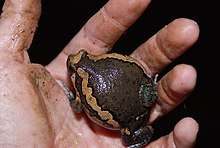Banded bullfrog
The banded bullfrog (Kaloula pulchra) is a type of frog in the microhylid (narrow-mouthed frog) family. It is also known as the Asian painted frog, rice frog, and bubble frog. In the pet trade, it is sometimes called the chubby frog. They have round bodies with mahogany brown backs and cream stomachs. The distinctive stripes down the side can range from copper-brown to salmon pink in color. Males have darker throats than females. Frogs grow to about 8 cm (3 in) with females generally being larger than males. They may live for as long as 10 years.[2]
| Banded bullfrog | |
|---|---|
%2C_Angkor_Wat%2C_Cambobia.jpg) | |
| At Angkor Wat, Cambodia | |
| Scientific classification | |
| Kingdom: | Animalia |
| Phylum: | Chordata |
| Class: | Amphibia |
| Order: | Anura |
| Family: | Microhylidae |
| Genus: | Kaloula |
| Species: | K. pulchra |
| Binomial name | |
| Kaloula pulchra Gray, 1831 | |
Distribution
This frog is native to mainland Southeast Asia, and usually lives on the forest floor, in rice fields, and even inside homes. These frogs are voracious eaters, and will eat flies, crickets, moths, grasshoppers, earthworms and more. Painted frogs hide under leaf litter during the day hours and eat in the evening.
Like many other narrow-mouthed frogs, painted frogs have the ability to expand themselves when threatened, and to secrete toxic glue-like substances from their bodies as a defense mechanism. They are also able to survive dry conditions by burying themselves in the ground and waiting for rain.[3]

Invasive species
The species is a potential invasive species. It has been introduced and become established in the Philippines,[4] Guam,[5] Singapore, Borneo and Sulawesi with specimens noted in Australia and New Zealand.[6][7][8]
Behaviour
%2C_young%2C_Angkor_Wat%2C_Cambodia.jpg)
In India, the frogs call after the first heavy monsoon showers in April–May. The males call while afloat in pools of water. The pulses of the calls recorded in India were 28–56 per second with a frequency range of 50–1760 Hz. In Thailand the dominant frequency was 250 Hz (duration 560–600 ms long) and 18–21 pulses/call.[9]
The tadpoles can metamorphose in as little as two weeks.[10]
Appetite
These frogs are big eaters and are very slow. They are primarily ant specialists, consuming up to a couple hundred ants in one night, and can often be found sitting along an ant trail picking off individuals one by one. Mealworms can be fed once a week or so if one Asian Painted Frog is kept at home, but should not make up most of its diet. They can be used as a laxative.
Pet trade
Chubby Frogs are commonly sold in pet stores. They are sensitive to chlorine in water. They are maintained in aquariums with substrate choices consisting of peat–soil mixes or potting soil with sphagnum moss. They need high humidity and prefer temperatures of 80–85 °F (27–29 °C).
References
- Kuangyang; et al. (2004). "Kaloula pulchra". The IUCN Red List of Threatened Species. 2004: e.T57855A86163405. doi:10.2305/IUCN.UK.2004.RLTS.T57855A11694615.en.
- Snider, A.T. & J.K. Bowler. (1992). Longevity of Reptiles and Amphibians in North American Collections. Second edition. Herpetological Circular No. 21.
- Sharon B. Emerson (1976). "Burrowing in frogs". Journal of Morphology. 149 (4): 437–458. doi:10.1002/jmor.1051490402. PMID 30257534.
- Brown, Rafe M.; Oliveros, Carl H.; Siler, Cameron D.; Fernandez, Jason B.; Welton, Luke J.; Buenavente, Perry Archival C.; Diesmos, Mae Lowe L.; Diesmos, Arvin C. (2012). "Amphibians and Reptiles of Luzon Island (Philippines), VII: Herpetofauna of Ilocos Norte Province, Northern Cordillera Mountain Range". Check List. 8 (3): 469–490. doi:10.15560/8.3.469. S2CID 18375419.
- Christy, M.; Savidge, J. & Rodda, G. (2007). "Multiple pathways for invasion of anurans on a Pacific island". Diversity & Distributions. 13 (5): 598–607. doi:10.1111/j.1472-4642.2007.00378.x.
- Tyler MJ; TF Chapman (2007). "An Asian species of frog (Kaloula pulchra, Microhylidae) intercepted at Perth International Airport, Australia". Applied Herpetology. 4: 86–87. doi:10.1163/157075407779766697.
- Gill, B.J.; Bejakovich, D.; Whitaker, A.H. (2001). "Records of foreign reptiles and amphibians accidentally imported to New Zealand". New Zealand Zool. 28 (3): 351–359. doi:10.1080/03014223.2001.9518274.
- Inger, R.F. (1966). "The systematics and zoogeography of the amphibia of Borneo". Fieldiana Zoology. 52: 1–402. doi:10.5962/bhl.title.3147.
- Kanamadi RD; GG Kadadevaru & H Schneider (2002). "Advertisement Call and Breeding Period of the Frog, Kaloula pulchra (Microhylidae)" (PDF). Herpetological Review. 33 (1): 19–21. Archived from the original (PDF) on 2011-07-27. Retrieved 2008-09-04.
- Richard D. Bartlett; Patricia P. Bartlett (1996). Frogs, Toads, and Treefrogs: Everything About Selection, Care, Nutrition, Breeding, and Behavior. Barron's Educational Series. p. 98. ISBN 978-0-8120-9156-4.
External links

- Amphibian and Reptiles of Peninsular Malaysia - Kaloula pulchra
